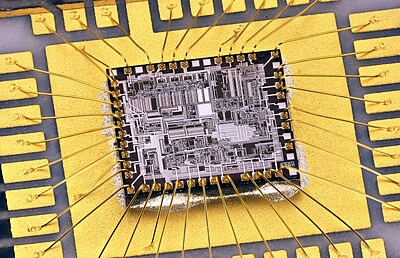Talk:Wire bonding
| This article is rated Start-class on Wikipedia's content assessment scale. It is of interest to the following WikiProjects: | |||||||||||
| |||||||||||
untitled[edit]
Please add new technologies of wire bonding using glass coated wires G.Kashian (talk) 09:31, 2 January 2017 (UTC) [1] and [2] and [3] this will solve the problems of oxidation of Cu.G.Kashian (talk) 09:31, 2 January 2017 (UTC) [4]G.Kashian (talk) 09:34, 2 January 2017 (UTC)
I came here to discover how they get the little wires to attach to the little chips at high rates, and came away without learning anything. —Preceding unsigned comment added by 173.52.156.157 (talk) 17:30, 22 November 2009 (UTC)
Is Cu used for wire bonding? I do not think that is possible. Cu suffers from fast oxidation which in practice leads to the use of NiAu or Au for wire bonding...
- I haven't heard about the use much, but according to this web page: Kulicke & Soffa it is possible. They just seal it for storage. --KingCarrot 15:34, 2 February 2006 (UTC)
Does anyone know if you can wire bond 80/20 Nichrome wire to pads on a PCB? If so, a competent source to do this would be greatly appreciated.
12.10.206.130 18:26, 6 September 2007 (UTC)
Huh? I thought soldering is still the "primary method" of putting ICs on boards. I was wondering if it's sometimes also used to connect ICs to PCB's in the case where the IC appears under a black epoxy blob, rather than packaged with conventional pins... but this article doesn't inspire confidence, starting off with an exaggeration like that.
Ecloud (talk) 07:54, 8 August 2010 (UTC)
- I was thinking the same thing. I'm fairly convinced that the primary method of connecting ICs to PCBs is through solder. It would probably be better to talk about wire bonding being the primary method of connecting a die to its package which seems more of an afterthought the way its currently worded.
- Potatoj316 (talk) 19:43, 28 April 2011 (UTC)
References
ATJ abbreviation[edit]
The first sentence of the article reads: Wire bonding is the method of making interconnections (ATJ). What does the abbreviation ATJ stand for? The only meaningful search result leads me back to this article. --134.147.40.133 (talk) 08:34, 12 July 2019 (UTC)
Material section needs to discuss materials in order of relevance including Silver[edit]
The "Materials" section includes a list of materials, including Silver, but the text discusses the materials in a different order and omits Silver. A better strategy would be to list and discuss the material in order of relevance, discussing all of the materias listed. Godot (talk) 09:49, 13 October 2020 (UTC)
A Commons file used on this page or its Wikidata item has been nominated for deletion[edit]
The following Wikimedia Commons file used on this page or its Wikidata item has been nominated for deletion:
Participate in the deletion discussion at the nomination page. —Community Tech bot (talk) 17:52, 21 January 2023 (UTC)
Featured picture scheduled for POTD[edit]
Hello! This is to let editors know that File:07R01.jpg, a featured picture used in this article, has been selected as the English Wikipedia's picture of the day (POTD) for February 13, 2023. A preview of the POTD is displayed below and can be edited at Template:POTD/2023-02-13. For the greater benefit of readers, any potential improvements or maintenance that could benefit the quality of this article should be done before its scheduled appearance on the Main Page. If you have any concerns, please place a message at Wikipedia talk:Picture of the day. Thank you! — Amakuru (talk) 22:44, 5 February 2023 (UTC)

|
Wire bonding is the method of making interconnections between an integrated circuit or other semiconductor device and its packaging during semiconductor device fabrication. This macro photograph depicts a integrated circuit that functions as an intermediate-frequency amplifier and demodulator in a transceiver, with gold wire ball-bonded on a silicon die. Photograph credit: Mister rf
Recently featured:
|

